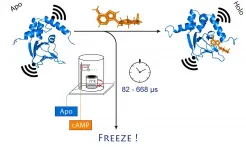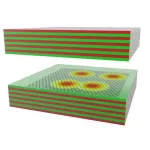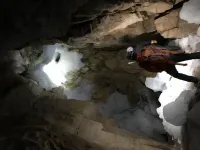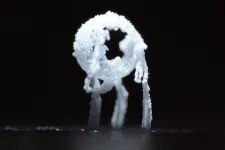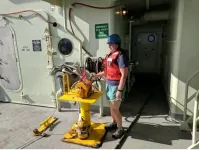(Press-News.org) In an effort to fight the millions of tons of marine litter floating in the ocean, Florida State University researchers have developed a new virtual tool to track this debris.
Their work, which was published in Frontiers in Marine Science, will help provide answers to help monitor and deal with the problem of marine litter.
Eric Chassignet, director of the Center for Ocean-Atmospheric Prediction Studies and professor in the Department of Earth, Ocean and Atmospheric Science.
"Marine litter is found around the world, and we do not fully understand its impact on the ocean ecosystem or human health," said Eric Chassignet, director of FSU's Center for Ocean-Atmospheric Prediction Studies (COAPS) and the paper's lead author. "That's why it's important to learn more about this problem and develop effective ways to mitigate it."
Marine litter is a big problem for the Earth's oceans. Animals can get entangled in debris. Scientists have found tiny pieces of plastic inside fish, turtles and birds -- litter that blocks digestive tracts and alters feeding behavior, altering growth and reproduction. Most of that marine litter is mismanaged plastic waste, which is of particular concern because plastics remain in the ocean for a long time.
Understanding where marine litter goes once it's in the ocean is a big part of understanding the issue and helping individual countries and the international community to develop plans to deal with the problem. The United Nations, which funded this work, is trying to mitigate the impact of mismanaged plastic waste, and this work can inform their policies and regulations.
Take the so-called Great Pacific Garbage Patch, a cluster of marine debris in the Pacific Ocean, for example. Tracking marine litter will help answer questions about whether it is growing larger and questions about how much plastic is breaking down or sinking to the bottom of the ocean. The virtual tool also shows how countries around the world are connected.
"Knowing where the marine litter released into the ocean by a given country goes and the origin of the litter found on the coastline of a given country are important pieces of information for policymakers," Chassignet said. "For example, it can help policymakers determine where to focus their efforts for dealing with this problem."
The tracking tool uses worldwide mismanaged plastic waste data as inputs for its model. The model uses data about ocean and air currents to track marine debris starting from 2010. Fire up the website and you can watch as colorful lines swirl across the Earth's oceans. It looks pretty -- until you realize it is tracking litter.
COAPS -- an interdisciplinary research center focusing on air-sea interaction, the ocean-atmosphere-land-ice earth system and climate prediction -- is 25 years old this year. Researchers at the center uses sophisticated ocean models to map the ocean and predict ocean currents that help scientists understand where marine litter released in the ocean is likely to travel and end its journey.
"If you have data for the past 20 years, a lot can be done in terms of modeling and simulations," Chassignet said.
INFORMATION:
COAPS researchers Xiaobiao Xu and Olmo Zavala-Romero were co-authors on this paper.
This work was supported by the United Nations Environment Programme.
Researchers at the University of Bonn and the research center caesar have succeeded in ultra-fast freezing proteins after a precisely defined period of time. They were able to follow structural changes on the microsecond time scale and with sub-nanometer precision. Owing to its high spatial and temporal resolution, the method allows tracking rapid structural changes in enzymes and nucleic acids. The results are published in the Journal of the American Chemical Society.
If you want to know what the spatial structure of a biomolecule looks like, you have a formidable arsenal of tools at your disposal. The most popular ones are electron microscopy and X-ray diffraction, which can reveal even the smallest ...
Researchers have long noted that readers with dyslexia employ eye movements that are significantly different from non-dyslexics. While these movements have been studied in small sample sizes in the past, a new paper written by Concordia researchers and published in the Nature journal END ...
The ability to turn on and off a physical process with just one photon is a fundamental building block for quantum photonic technologies. Realizing this in a chip-scale architecture is important for scalability, which amplifies a breakthrough by City College of New York researchers led by physicist Vinod Menon. They've demonstrated for the first time the use of "Rydberg states" in solid state materials (previously shown in cold atom gases) to enhance nonlinear optical interactions to unprecedented levels in solid state systems. This feat is a first step towards realizing chip-scale scalable single photon switches.
In solid state systems, exciton-polaritons, half-light ...
Nearly one quarter of the land in the Northern Hemisphere, amounting to some 9 million square miles, is layered with permafrost -- soil, sediment, and rocks that are frozen solid for years at a time. Vast stretches of permafrost can be found in Alaska, Siberia, and the Canadian Arctic, where persistently freezing temperatures have kept carbon, in the form of decayed bits of plants and animals, locked in the ground.
Scientists estimate that more than 1,400 gigatons of carbon is trapped in the Earth's permafrost. As global temperatures climb, and permafrost thaws, this frozen reservoir could potentially escape into the ...
Chestnut Hill, Mass. (4/28/2021) -- The vast frozen terrain of Arctic permafrost thawed several times in North America within the past 1 million years when the world's climate was not much warmer than today, researchers from the United States and Canada report in today's edition of Science Advances.
Arctic permafrost contains twice as much carbon as the atmosphere. But the researchers found that the thawings -- which expel stores of carbon dioxide sequestered deep in frozen vegetation -- were not accompanied by increased levels of CO2 in the atmosphere. The surprising finding runs counter to predictions that as the planet ...
About a quarter of a percent of the entire gross domestic product of industrialized countries is estimated to be lost through a single technical issue: the fouling of heat exchanger surfaces by salts and other dissolved minerals. This fouling lowers the efficiency of multiple industrial processes and often requires expensive countermeasures such as water pretreatment. Now, findings from MIT could lead to a new way of reducing such fouling, and potentially even enable turning that deleterious process into a productive one that can yield saleable products.
The findings are the result of years of work by recent MIT graduates Samantha McBride PhD '20 and Henri-Louis Girard PhD '20 with professor of mechanical ...
Two teams have created a new generation of highly specific CAR T cells, which safely cleared solid tumors in mice with mesothelioma, ovarian cancer, and the deadly brain cancer glioblastoma while outlasting and outperforming conventional CAR T cell designs. The results suggest these cells could minimize the risk of dangerous side effects and address the traditionally poor performance of CAR T cells against solid tumors in the clinic. CAR T cells are genetically modified human T cells and have shown impressive performance in patients with leukemia. However, CAR T cells don't work as well against solid tumors, as these cancers lack molecular targets that the cells can easily recognize. ...
The number of distinctive sources and voices on the internet is proven to be in long-term decline, according to new research.
A paper entitled 'Evolution of diversity and dominance of companies in online activity' published in the PLOS ONE scientific journal has shown between 60 and 70 percent of all attention on key social media platforms in different market segments is focused towards just 10 popular domains.
In stark contrast, new competitors are struggling to survive against such dominant players, with just 3 percent of online domains born in 2015 still active today, compared to nearly 40 percent of those formed back in 2006.
The researchers say ...
The subseafloor constitutes one of the largest and most understudied ecosystems on Earth. While it is known that life survives deep down in the fluids, rocks, and sediments that make up the seafloor, scientists know very little about the conditions and energy needed to sustain that life.
An interdisciplinary research team, led from ASU and the Woods Hole Oceanographic Institution (WHOI), sought to learn more about this ecosystem and the microbes that exist in the subseafloor. The results of their findings were recently published in Science Advances, with ASU School of Earth and Space Exploration assistant professor and geobiologist ...
Organ development in plants mostly occurs through combinatorial activity of so-called meristems. Meristems are plant cells or tissues that give rise to new organs, similar to stem cells in human - including spikelets. Spikelets are components of the spike and form florets (flowers) themselves, which in turn produce grains after fertilisation.
Inflorescence morphogenesis in grasses (Poaceae) is complex and based on a specialised floral meristem, the spikelet meristem, from which all other floral organs arise and which also gives rise to the grain. The fate of the spikelet thus determines not only reproductive success, ...
